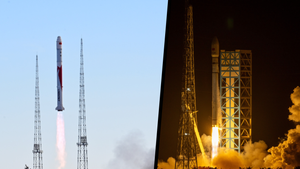
Jul 22, 2024
Chinese launch sites and China's launchsite bottleneck
In the vast deserts of northwest China is where the country's space dreams once took off. More than four decades ago at Jiuquan Satellite Launch Center, China's first satellite was launched. It was called Dong Fang Hong 1.
JSLC is usually used to launch vehicles into lower and medium orbits with large orbital inclination angles, as well as testing medium to long-range missiles. The center also has housing for around 20,000 people for employees and launch support equipment initially modeled after the Soviet Union's designs. The launch site was chosen deep inland during the Cold War so that it could not be easily struck in an attack on China. The space launch site is still in operation today, launching legacy vehicles as well as supporting the Shenzhou crewed program. In the late 2010s the launch site also hosted some private entities' launch vehicles such as i-Space and their Hyperbola-1.

Similar to many space programs, China's was a spinoff of its missile program. Due to this, their rockets use what many countries deem outdated propellants. The propellants they use are extremely toxic and dangerous, their fumes are deadly. These propellants are classified as hypergolics, they are used usually due to their ease of storing for long periods of time and their highly combustible nature.
Their second launch site, Taiyuan was built for polar launches. The facility was built as part of China's Third Front campaign to develop basic industry and national security in China's rugged interior in case of invasion by the Soviet Union or the United States. The facility is still in operation today launching rockets from China's Long March series.

Taiyuan sits at an altitude of 1500 meters and its dry climate makes it an ideal launch site. The site is primarily used to launch meteorological satellites, Earth resource satellites, and scientific satellites.
The final launch site apart of China's Third Front campaign was Xichang. The facility became operational in the early 1980s and launches many international cooperative payloads. It also launches science and military satellites.
The Booster problem
When choosing the best candidate for a launch site many factors come into play, rockets typically pitch eastward to enter orbit. Launch sites closer to the equator also benefit from extra speed from the rotation of the earth. (there are exceptions but these are the broad strokes) In a rush to catch up with Soviet and American space industries' safety standards over the years, China has ramped up its cadence of rocket launches, still launching from legacy missile test facilities. As China has ramped up cadence there have been horrible tragedies where people have been exposed to carcinogenic propellants, had their property damaged or destroyed, and put under immense stress.
Nobody as of 2024 has died directly from the boosters falling due to a few limiting factors. Most notably evacuation notices sent out beforehand by predicting where the boosters will fall and sending out exclusion zones to the local government. Cleanup crews are also often quickly dispatched usually consisting of local police and trained crews.
However there have been many incidents where people have found and touched debris before crews could get there, and incidents where local governments have failed to evacuate regions. Although deaths and injuries have been highly limited it is still a poor safety practice often looked down upon.
The worst danger from the boosters falling is the cancerous fumes, while exposure is limited it does pose a real danger.
Xichang
Xichang is an especially hazardous launch site due to its need to launch GEO payloads it was constructed in Southern, China. It has been the worst offender of boosters dropping near populated zones due to its proximity.

China's more relaxed legislation makes this a highly controversial launch site and its continued operation is debated. The Long March 3B launches from this launch site especially has also had several issues due to its architecture. Not all legacy vehicles have the same issues, the Long March 3b has been the worst offender and has also been the focus of most scrutiny.

When the Long March 3b launches it discards the four side boosters which then tumble out of control, they're harder to predict and multiple of them make predicting their landing zones harder.
Over the years China at first just issued normal evacuation notices but after those didn't work they issued evacs, and told the entire surrounding villages to turn off their power grid, and to not go near the boosters, CAST (the specific launch operator for the Long March 3B) then started using parachutes on the 3B boosters to better predict where their landing zones would be more accurately predicted.
SAST has also employed grid fins on Long March 2D boosters to redirect them and again more accurately predict their landing zones. All of these are China's attempts at mitigating the booster problem and it has been largely successful. We've also found up close pictures have gotten exceedingly rare. Of course, mishaps happen in spaceflight all the time and the relaxed safety concerns are not at all to be accepted as a long-term solution. As China ramps up cadence this is where China's launchsite bottleneck issue is most clear. As China develops, and as China's space program develops they have to implement more permanent solutions.
Wenchang
Wenchang has been constructed and continues to be expanded on the coast of Hainan. This launch center is very modest with only a handful of launches each year has the possibility to be the most active spaceport in the world. The most notable feature of Wenchang is its China's first coastal spaceport. Meaning all debris is guaranteed to fall into the ocean.
It is China's attempt to move more launches away from the overused launch sites in the inland of China. It also almost exclusively uses more modern rockets that do not utilize hypergolics making them even less of a hazard. It is a part of China's modernization approach for their space program.
Up until the 2010s China relied on three landlocked launch centers as we discussed earlier, they launch the older generation Long March 2-4. These launch pads have the booster problem we mentioned earlier. While these villages are typically evacuated beforehand and they minimize exposure through several ways it's not a sustainable model as China's cadence ramps up.
Another contributing factor to China's launch site bottleneck issue is the size of their rockets. Chinese rocket parts are usually transported through the national railway system. The maximum diameter they can fit is 3.35 meters. None of these traditional launch sites are also ideal for launching to a Geostationary orbit as opposed to Wenchang.
China's new modern rocket the Long March 5 for instance uses a 5m diameter in its core.
The Wenchang space project was validated in 2007 with construction starting in 2009. The 2000s and 2010s were arguably the worst time for China's booster problem. It became a glaringly obvious issue with photos circulating of people directly being exposed to the rocket debris. Most modern incidents have been better at predicting where they'd fall and recovering them however. Yet China has received widespread criticism due to the frequent failures such as this year when a rocket launch from Xichang landed over a populated area that the local government failed to evacuate.
The Wenchang Space Launch Site was officially declared an operational space launch facility in 2016. Wenchang Space Launch Site gained its name from the large city nearby named Wenchang. However, it's technically located inside of Longlou with that being the nearest population zone to it.
The Wenchang launch center can send 7-15% more payload than Xichang, the location and proximity to the sea help with the booster issue. Its rocket parts are also not delivered by rail but instead by port with rocket parts being mainly constructed in Tianjin. They are then brought to the launch site finally by road.
There's a VAB for the Long March 5 and a medium for smaller rockets. They use a mobile launch platform that then brings the rocket to the launch pad. There are LC-101 and LC-201. The cadence of launch however remains rather modest. Yet similarly to the US China's cadence has been gradually increasing and more focus is being placed on the Wenchang infrastructure. With Long March 10 under construction, two commercial pads under construction, and a rocket factory under production. China plans on launching 50 Long March 8A's a year from Wenchang alone.
The newest pad is actually debuting this year, with the Long March 12. This pad is also compatible with numerous commercial rockets such as the Tianlong-3, Zhuque-3, and more. As China develops Wenchang, crewed launches will be taking place there, their crewed lunar missions will take place there, their super heavy-lift rocket will launch from there.

Reusability
Launch, land, and reuse. Ever since the success of SpaceX, and the growth in the constellation market Chinese launch providers have focused more and more on reuse. China was already aware of its launch site issue, and reusability was seen as a way to ensure that it would be controlled. They also saw the clear economic benefits and immediately jumped on it.
China's launch sector is immensely cut off from the rest of the world due to bans placed on China by the US so many private companies have pitched SpaceX-like rockets to be China's SpaceX. Yet State-owned enterprises have also been heavily interested in reuse, pitching starship and Falcon 9-inspired designs.
New policies and regulations started to be written that allowed commercial rockets in China. Over a dozen commercial launch companies were founded. A group of engineers from China's space sector would then start their own company and pitch for funding from the government and venture capitalists. Slowly these companies whittled down.
These companies gained some recognition after successfully delivering payloads to orbit using lightweight solid-fuel rockets. Others had a more rocky start but bounced back, such as LandSpace who pivoted purely towards liquid rockets.
In the 2020s, many companies then took a pivot towards liquid-fueled rockets. Chinese launch startups generally developed their own engines with reusability in mind. Several companies, including state-owned enterprises, then did low-level hops of test prototypes to gain experience in landing. Deep Blue Aerospace, Landspace, SAST, and more all went down this path. With CALT also announcing and working on their Long March 10 rocket that would reportedly use reuse on different configurations. State-owned enterprises also explored reuse of the Long March 8. They also reviewed reusing older rocket parts as they started recovering them by parachute.
This was a very noticeable shift in China's space sector that would open up possibly more launches from older launch sites, as LandSpace has wanted to launch their Zhuque-3 from Jiuquan. The Zhuque-3 using reuse would mean that theoretically it launching was not an issue as it could propulsively land and guide itself onto a landing pad.
China also catered to this large influx of Commercial operators by opening up the commercial pad in Wenchang which would ensure more traffic to that space port.



Sea Launch
Haiyang Spaceport, on the coast of the eastern province of Shandong. This province being the place of a spaceport is highly unusual but it becomes more clear when you see that it is a rather unconventional spaceport. The spaceport uses sea launch platforms that go out into the sea to launch what are typically light-lift solid rockets. It further shows how China wants to diversify away from inland launch sites.
China carried out its first sea launch in June of 2019 using the Long March 11. The new capability shows rapid response capabilities. It also shows a shift to a safer launch system. With more launch providers pivoting or opening up sea launch as an option. Such as Galactic Energy previously stating it could launch their Pallas-1 rocket from sea.
This spaceport opened up when China's space launch cadence was rapidly increasing.

Kazakhstan
The most recent news that could contribute to solving China's launch site bottleneck issue comes from an unlikely place. Kazakhstan hosts what is quite possibly the most famous spaceport, Baikonur.

The Minister of Aerospace Industry of Kazakhstan wrote in a social media post
"In addition, within the framework of another memorandum signed, it is planned that the parties will cooperate in the process of establishing and utilizing the International Scientific Moon Station. With this, our specialists will gain competence and experience in applying high technology in the field of deep space exploration."
Along with this, several grants and cooperation agreements were signed. This involved cooperation between Kazakh and Chinese industries. A notable aspect of this growing cooperation is the potential for commercial use of each other’s spaceports by Kazakhstan and China. This move could diversify Kazakhstan’s space activities and reduce its dependence on Russian facilities. More notably it could also reduce China's dependence on its inland facilities.
As Chinese rockets are typically delivered by rail it remains theoretically possible. It would most likely have to be the older rockets or a solid-fueled rocket. As some of China's more modern rockets can't be delivered by rail.
Concluding Thoughts
As China seeks to modernize their space sector, and ramp up cadence it opens up several pathways to deal with their limiting launch-site locations. Plagued by more relaxed safety standards and uncharted territory China has had many failures on the part of the launch provider and local government. They've also had many successes and remain dedicated towards diversifying away from inland launch sites.



